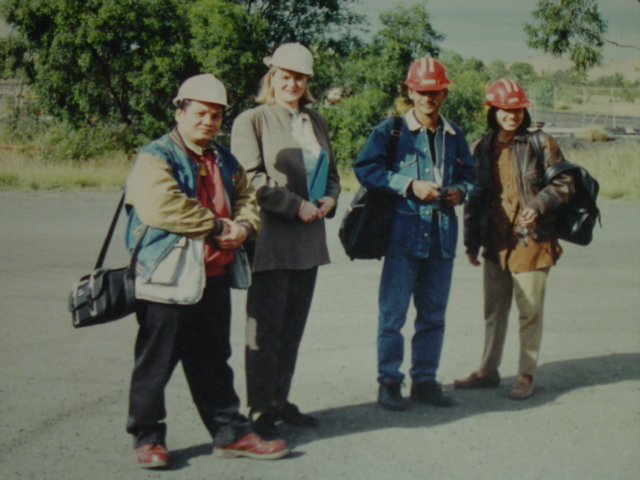The power and the glory
The next technology boom may well be based on alternative energy. But which sort to back?
EVERYONE loves a booming market, and most booms happen on the back of technological change. The world’s venture capitalists, having fed on the computing boom of the 1980s, the internet boom of the 1990s and the biotech and nanotech boomlets of the early 2000s, are now looking around for the next one. They think they have found it: energy.
Many past booms have been energy-fed: coal-fired steam power, oil-fired internal-combustion engines, the rise of electricity, even the mass tourism of the jet era. But the past few decades have been quiet on that front. Coal has been cheap. Natural gas has been cheap. The 1970s aside, oil has been cheap. The one real novelty, nuclear power, went spectacularly off the rails. The pressure to innovate has been minimal.
In the space of a couple of years, all that has changed. Oil is no longer cheap; indeed, it has never been more expensive. Moreover, there is growing concern that the supply of oil may soon peak as consumption continues to grow, known supplies run out and new reserves become harder to find.
The idea of growing what you put in the tank of your car, rather than sucking it out of a hole in the ground, no longer looks like economic madness. Nor does the idea of throwing away the tank and plugging your car into an electric socket instead. Much of the world’s oil is in the hands of governments who have little sympathy with the rich West. When a former head of  ence on imported oil.
ence on imported oil.
The price of natural gas, too, has risen in sympathy with oil. That is putting up the cost of electricity. Wind- and solar-powered alternatives no longer look so costly by comparison. It is true that coal remains cheap, and is the favoured fuel for power stations in industrialising
In theory, there is a long queue of coal-fired power stations waiting to be built in
That has opened up a capacity gap and an opportunity for wind and sunlight. The future price of these resources—zero—is known. That certainty has economic value as a hedge, even if the capital cost of wind and solar power stations is, at the moment, higher than that of coal-fired ones.
The reasons for the boom, then, are tangled, and the way they are perceived may change. Global warming, a long-range phenomenon, may not be uppermost in people’s minds during an economic downturn. High fuel prices may fall as new sources of supply are exploited to fill rising demand from
Global warming certainly will not. “Peak oil”, if oil means the traditional sort that comes cheaply out of holes in the ground, probably will arrive soon. There is oil aplenty of other sorts (tar sands, liquefied coal and so on), so the stuff is unlikely to run out for a long time yet. But it will get more expensive to produce, putting a floor on the price that is way above today’s. And political risk will always be there—particularly for oil, which is so often associated with bad government for the simple reason that its very presence causes bad government in states that do not have strong institutions to curb their politicians.
A prize beyond the dreams of avarice
The market for energy is huge. At present, the world’s population consumes about 15 terawatts of power. (A terawatt is 1,000 gigawatts, and a gigawatt is the capacity of the largest sort of coal-fired power station.) That translates into a business worth $6 trillion a year—about a tenth of the world’s economic output—according to John Doerr, a venture capitalist who is heavily involved in the industry. And by 2050, power consumption is likely to have risen to 30 terawatts.
Scale is one of the important differences between the coming energy boom, if it materialises, and its recent predecessors—particularly those that relied on information technology, a market measured in mere hundreds of billions. Another difference is that new information technologies tend to be disruptive, forcing the replacement of existing equipment, whereas, say, building wind farms does not force the closure of coal-fired power stations.
For both of these reasons, any transition from an economy based on fossil fuels to one based on renewable, alternative, green energy—call it what you will—is likely to be slow, as similar changes have been in the past (see chart 1). On the other hand, the scale of the market provides opportunities for alternatives to prove themselves at the margin and then move into the mainstream, as is happening with wind power at the moment. And some energy technologies do have the potential to be disruptive. Plug-in cars, for example, could be fuelled with electricity at a price equivalent to 25 cents a litre of petrol. That could shake up the oil, carmaking and electricity industries all in one go.
The innovation lull of the past few decades also provides opportunities for technological leapfrogging. Indeed, it may be that the field of energy gives the not-quite-booms in biotechnology and nanotechnology the industrial applications they need to grow really big, and that the three aspiring booms will thus merge into one.
The possibility of thus recapturing the good times of their youth has brought many well-known members of the “technorati” out of their homes in places like
Vinod Khosla, one of the founders of Sun Microsystems, is turning his considerable skills as a venture capitalist towards renewable energy, as are Robert Metcalfe, who invented the ethernet system used to connect computers together in local networks, and Mr Doerr, who works at Kleiner Perkins Caufield & Byers, one of
This renewed interest in energy is bringing forth a raft of ideas, some bright, some batty, that is indeed reminiscent of the dotcom boom. As happened in that boom, most of these ideas will come to naught . But there could just be a PayPal or a Google or a Sun among them.
. But there could just be a PayPal or a Google or a Sun among them.
More traditional companies are also taking an interest. General Electric (GE), a large American engineering firm, already has a thriving wind-turbine business and is gearing up its solar-energy business. The energy researchers at its laboratories in
Meanwhile, BP and Shell, two of the world’s biggest oil companies, are sponsoring both academic researchers and new, small firms with bright ideas, as is DuPont, one of the biggest chemical companies. Not everyone has joined in. Exxon Mobil, the world’s largest oil company not in government hands, is conspicuously absent. But in many boardrooms renewables are no longer seen as just a way of keeping environmentalists off companies’ backs.

Some people complain that many existing forms of renewable energy rely on subsidies or other forms of special treatment for their viability. On the surface, that is true. Look beneath, though, and the whole energy sector is riddled with subsidies, both explicit and hidden, and costs that are not properly accounted for. Drawing on the work of people like Boyden Gray, a former White House counsel, Mr Woolsey estimates that American oil companies receive preferential treatment from their government worth more than $250 billion a year. And the Intergovernmental Panel on Climate Change (IPCC), a United Nations-appointed group of scientific experts, reckons that fossil fuels should carry a tax of $20-50 for every tonne of carbon dioxide they generate in order to pay for the environmental effects of burning them (hence the fears of the power-generators).
So the subsidies and mandates offered to renewable sources of power such as wind turbines often just level the playing field. It is true that some subsidies amount to unwarranted market-rigging: examples include those handed by cloudy
If the world were rational, all of these measures would be swept away and replaced by a proper tax on carbon—as is starting to happen in
The poor world turns greener too
That, at least, is the view from the rich world. But poorer, rapidly developing countries are also taking more of an interest in renewable energy sources, despite assertions to the contrary by some Western politicians and businessmen. It is true that
Brazil, meanwhile, has the world’s second-largest (just behind America) and most economically honest biofuel industry, which already provides 40% of the fuel consumed by its cars and should soon supply 15% of its electricity, too (through the burning of sugarcane waste).
That, however, requires innovation. Such innovation is most likely to come out of the laboratories of rich countries. At a recent debate at
As it happens, he lost. But that does not mean he is wrong. There are lots of terawatts to play for and lots of money to be made. And if the planet happens to be saved on the way, that is all to the good.
Source : The Economist, June 19th, 2008












